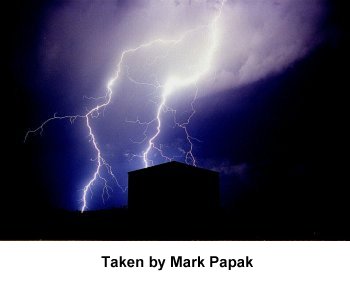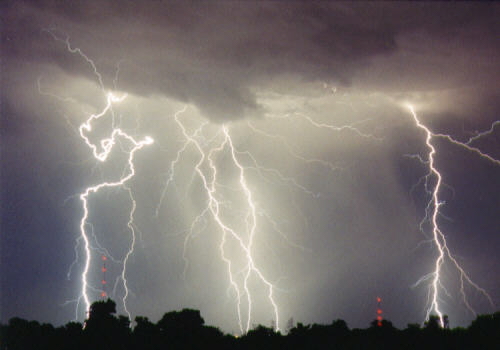| CURRENT CONDITIONS
|
|
 |
ABOVE PHOTO: SEVERE STORM NEAR IOWA PARK TEXAS
|
PHOTO BY MARK PAPAK |
STORMCHASING
|
Every storm chaser knows what a tornado is capable of. We all know that they can be spontaneous, violent columns of destruction that can hit with little or no warning. If we're accidentally caught under the wrong part of a storm at the wrong time, our families can get some very unpleasant news that we're unable to deliver ourselves.
The same goes for every single person who lives in our communities. If a tornado hits a community where the residents did not have time to take adequate precautions, the results can be fatal. People don't have to be told twice what a tornado can do to them - they've all seen enough pictures to learn from the misfortune of others. The trick to minimizing (and often preventing) loss of life in tornadic events is getting warnings out early enough for people to take cover. As little as 30 seconds worth of delay in warning can result in additional fatalities.
The vast majority of those of us who chase storms are out there to do what we can to help our communities win the warning game. This happens on many many levels. At one end of the spectrum are people like the folks out at the National Severe Storms Laboratory. These people, as well as many others, are doing serious research to develop advanced warning abilities. At the other end, we have people like a group I chase with who are just trying to help the current warning methods to work as quickly as possible. Sure, we do it because severe weather intrigues us, but most of us are also doing it because we know lives can be saved. That means a lot to us.
Public service is a perfectly fine reason to chase storms, but, in reality, it's admiration of what Mother Nature can do which brings a lot of chasers back for more. Severe storms are huge, organized structures which just seem to happen out in the open air. The amount of energy tied up in a good storm cell is amazing, and it just happens all by itself. We don't (can't) do anything to help or hinder it - it's just there and it is truly remarkable.
|

|
WHY TAKE PICTURES OF NATURE?
|
TAKING PICTURES OF NATURE CAN BE A VERY INTRESTING AND REWARDNG HOBBY. BESIDES TAKING PICTURES OF WEATHER PHENOMENON DURING CHASING STORMS ONE CAN RUN ACROSS MANY OTHER PHOTOGENIC SCENES. SUNSETS, METEORS, COMETS, STARS, PLANETS, RAINBOWS, SNOW, ICE, ANIMALS, TREES, PLANTS, EVEN PEOPLE ETC.
IT OPENS THE IMAGINATION TO WANT TO UNDERSTAND HOW SOMETHING SO BEAUTIFUL (OR IN SOME CASES POWERFUL)CAN BE CREATED NATURALLY EVEN OUT OF THIN AIR.
CAPTURING THESE EVENTS ON FILM FREEZES THE IMAGE IN TIME. IT IS A FROZEN IMAGE OF HOW THE SCENE LOOKED TO YOU AT THAT EXACT MOMENT. IT IS A SCENE NOT PREPARED (OR MANY TIMES EVEN ALTERED BY MAN) BUT CREATED ONCE AND NEVER AGAIN BY THE MOST POWERFUL HAND IN EXISTENCE.....GOD. |
|
RIGHT: STRONG STORM NEAR WICHITA FALLS TEXAS ON 7/29/02
|
PHOTO RIGHT: TAKEN BY JASON BROCK |